Manipulating Space
Spatial controllers help engineers and designers get a handle on using a host of 3D MCAD applications.
Latest News
November 1, 2005
By Mark Clarkson
3D MCAD is all the rage, but how does today’s savvy engineer navigate the virtual space within his or her favorite MCAD application? The answer, it turns out, depends on the particulars of your job. Are you testing virtual prototypes? Creating original organic designs? Using reverse engineering methods? Designing simple enclosures? Your answer dictates your choice.
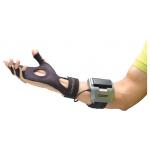 |
| Immersion’s CyberGlove allows users to move and alter objects in the digital arena to check all sorts of design details. It is available with or without force feedback. The version shown is the wireless model. |
Spatial controller is a term used to refer to input devices designed specifically to navigate within virtual 3D space, and to create and manipulate objects within it. The archetypical spatial controller is the data glove. This glove is fitted with tracking devices and, sometimes, attached to a motorized armature to push and pull at your fingers and hand, providing tactile feedback as you manipulate virtual objects. (This is often referred to as “force feedback” or haptics.) Data gloves were among the first spatial controllers developed, decades ago, and they continue to evolve and sell today. One such device is the CyberGlove from Immersion, available with and without force feedback.
“The CyberGlove is focused on immersive review and digital mockup,” says Chris Ullrich, Immersion’s director of applied research. “You’ve designed a product in 3D CAD, and now you want to interact with it, in real time, without having to build a physical prototype. Immersion’s VirtualHand software gives you one or two hand representations within the virtual environment. Using CyberGloves, you can touch parts and move them around ... see how the kinematics work, and, if you can, reach certain places. This saves you the time and cost of building a physical prototype.”
“The flip side of the coin,” says Ullrich, “is the beginning of the design cycle, where you create or import models ... there, you might use Immersion’s MicroScribe.”
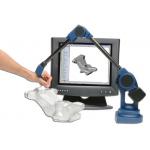 |
| Immersion’s MicroScribe MLX allows the sampling of points from real-world objects. |
The MicroScribe is basically a stylus mounted on an articulated arm, with five or six degrees of freedom, accurate to between 0.017 in. and 0.004 in., depending on the model. The MicroScribe lets you sample points from real-world objects by touching them. You might imagine the results as an untidy point cloud, but the MicroScribe works even better in a parametric MCAD environment, says Ullrich. “You decide which parameters you want to capture—say, radii or length. You take very specific, high-accuracy measurements at those points, then use those measurements with the plug-in tools to define a parametric geometry in your CAD software.”
MicroScribes are also useful in the inspection process; with appropriate software, you can measure points on manufactured parts and compare them to the original 3D MCAD model. Virtual Clay
If you’re creating original content—especially models with complex or organic shapes—you might want to consider something like SensAble’s Phantom. The Phantom looks, at first glance, a bit like the MicroScribe, but it’s designed for modeling rather than measurement.
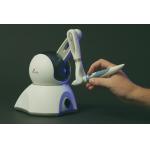 |
| SensAble Technologies developed the Phantom for modeling rather than measurement. When combined with the company’s FreeForm Modeling software or similar programs, it acts as a tool for sculpting |
The Phantom’s stylus, mounted on an articulated arm, acts as one of many tools for sculpting “virtual clay.” The Phantom’s force feedback provides a sense of touch.
SensAble offers FreeForm Modeling software, designed specially around the Phantom, as well as plug-ins for Rhino 3D, and Discreet 3DS Max, and Maya. Ergonomics
3D spatial controllers, it turns out, date back to the mid-1960s. So why haven’t they caught on yet? There are a host of reasons.
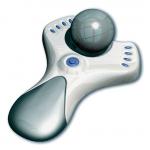 |
| The Astroid 3D motion controller from Spatial Freedom was developed by John Hilton, who invented the SpaceBall. |
“With most spatial controllers,” says John Hilton of Spatial Freedom, “you hold your arm in the air and move a glove, or stylus, or something around in space. That’s very intuitive, very similar to what we do in the real world, but ... I came to the conclusion that the failing of most 3D devices was that your arm gets tired.” It turns out that most people, in most situations, prefer to get by with a comfortable 2D device rather than hold a hand in the air for very long.
With ergonomics in mind, Hilton invented the SpaceBall: a controller that looks like a mouse turned inside-out. It might be less intuitive than, say, a data glove, but its comfort factor comes into play when you’re working for hours on end. The SpaceBall is part of a line of 3D spatial controllers from 3Dconnexion, which also includes the SpaceMouse, SpacePilot, and SpaceTraveler.
Hilton, meanwhile, has a new company—Spatial Freedom—whose Astroid controller competes in the same market.
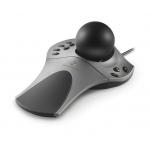 |
| 3Dconnexion’s SpaceBall 5000 was designed to be comfortable and is part of a line of 3D spatial controllers targeted at MCAD users. Such controllers are relatively familiar to the average engineer. |
While the other controllers we’ve discussed are pretty specialized, the SpaceBall and Astroid are targeted at plain old 3D MCAD, and are relatively familiar to the average engineer. Economics
There’s another reason that SpaceBall-type controllers are found at many designer workstations: affordability. The Phantom and accompanying software goes for $2,000 and more. The MicroScribe ranges from $4,500 up to $12,000.
Immersion’s VirtualHand software for CATIA V5 runs $15,000 to $30,000 depending on the environment. The glove itself starts at about $12,000, without force feedback, and goes all the way up to $100,000-plus with all the goodies. Admittedly, cost is relative. If you’re, say, GM or Boeing, the savings in both time and money can easily justify an investment of $100,000 or more. But even GM and Boeing can’t afford to put a $100,000 system on every engineer’s desk.
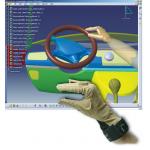 |
| CAA V5-based software available from Immersion enables the CyberGlove to interact with CATIA. Here, the wearer of the glove can manipulate the automobile interior’s controls to check for fit and ergonomic compatibility. |
A SpaceBall, in contrast, costs about $500. Spatial Freedom’s Astroid pushes the price point down even further, to $150. The Driver Problem
There’s a final hurdle for spatial controllers: software support. “You can’t just come up with OS drivers to control the 3D view or motion,” says Hilton. “There’s no standard 3D interface. You’ve got to actually vary the motion algorithm inside each 3D application. To be successful, a spatial controller must get those motion algorithms into key CAD programs, individually. That’s a real barrier for new classes of devices.”
But Hilton reminds us that the mouse languished, unsupported, for 20 years, taking off only when GUI operating systems appeared with built-in mouse support. “The same is true of spatial controllers,” he says. “They need the right interface in place before the hardware sales take off. But I believe that’s inevitable. As the popularity of these devices grows, companies like Microsoft will provide native support as part of the OS, and 3D programs will interface with spatial controllers as a standard element.
“Maybe I’m biased, but I think spatial controllers will become the next standard item on the engineer’s desktop, next to the keyboard and the mouse.”
Writer and artist Mark Clarkson’s latest book is Photoshop Elements by Example. Visit him on the Web at markclarkson.com or send e-mail about this article by clicking here.
SpaceTraveler Goes More Lightly
In late October, 3Dconnexion lowered the price for its entry-level 3D motion controller SpaceTraveler by half to $199. The company hopes that with the new entry-level price point it can rapidly expand its user base beyond the 350,000 it says currently use its products.
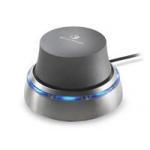 |
| The SpaceTraveler 3D motion controller from 3Dconnexion. |
In a telephone discussion with DE, a company spokesperson cited two factors that lead to the price reduction. First, he noted that 3Dconnexion had come to recognize that the high price for an entry-level unit discouraged potential users from trying 3D motion controllers. So, it started to experiment with different pricing models. After running several pricing tests, the company was sufficiently encouraged by the response to reduce the SpaceTraveler’s price permanently.
3Dconnexion, which is part of Logitech, has also begun to take advantage of its parent company’s operations and logistics infrastructure to better leverage supply chain and distribution efficiencies. This, in turn, has resulted in a lower cost structure for the SpaceTraveler. The savings could then be passed on to consumers.
The SpaceTraveler features eight programmable buttons that allow users to customize the unit for various application shortcuts. It supports more than 120 applications and comes with a three-year warranty.
SpaceTraveler has won several awards including Desktop Engineering’s Reader’s Choice Award, Game Developer Magazine’s 2003 Finalist Award, and Animation Magazine’s Seal of Excellence Award. SpaceTraveler is available immediately on 3Dconnexion’s website as well as through it worldwide distributors, resellers, and selected OEMs.—DE
Prooduct Information
SpaceBall, SpaceMouse, SpacePilot, SpaceTraveler
3Dconnexion
Los Gatos, CA
MicroScribe, CyberGlove, VirtualHand for V5
Immersion Corp.
San Jose, CA
Phantom, FreeForm Modeling
SensAble Technologies, Inc.
Woburn, MA
Astroid
Spatial Freedom, Inc.
Needham Heights, MA
Subscribe to our FREE magazine, FREE email newsletters or both!
Latest News
About the Author
Mark ClarksonContributing Editor Mark Clarkson is Digital Engineering’s expert in visualization, computer animation, and graphics. His newest book is Photoshop Elements by Example. Visit him on the web at MarkClarkson.com or send e-mail about this article to [email protected].
Follow DE





